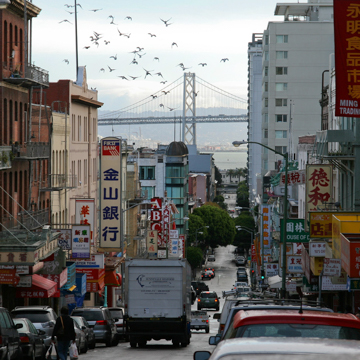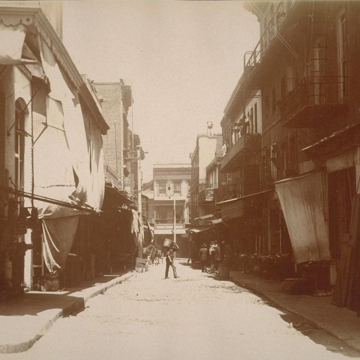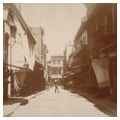San Francisco’s Chinatown covers an area of twenty-four square blocks and was originally defined as an area bounded by the San Francisco Bay and Bush, Taylor, and Bay streets. Located in the neighborhoods of North Beach and Telegraph Hill, it is the oldest Chinatown in the United States.
In 1847, a Chinese merchant named Chum Ming emigrated from China’s Guangdong Province and arrived in San Francisco to become the city’s first documented migrant from China. With the discovery of gold in the region, hundreds of Chinese goldseekers arrived in the city over the next few years. Many became mine workers or laborers for the transcontinental railroad, or other labor-intensive industries such textile, cigar, or shoe manufacturing. After the Gold Rush, many immigrants were financially motivated to remain in the growing metropolis, establishing businesses and retail shops.
As early as 1855, Chinese migrants were living in the section of San Francisco that became known as Chinatown, formed as a relatively safe enclave from racially motivated violence. Located below Nob Hill, next to the Financial District and just north of the Central Business District, the community sat between the commercial and residential neighborhoods of the city. In this city-within-a-city, people from a wide spectrum of economic classes were squeezed into tiny apartments without indoor plumbing or adequate ventilation. In 1870, the Cubic-Air Ordinance was selectively enforced in Chinatown, imposing fines and jail terms against Chinese lodging house owners for not providing adequate air space per lodger. Additional official ordinances unfairly imposed on Chinese-owned businesses left them with limited economic opportunities and Chinatown became a ghetto of ten square blocks. To compound the challenges, a two-day riot waged against Chinese immigrants in July 1877 resulted in four deaths and the destruction of more than $100,000 worth of property belonging to the city's Chinese immigrant population.
Anti-Chinese sentiment spread throughout the United States, culminating in the passage of Chinese Exclusion Act of 1882 (not repealed until 1943), which banned the immigration of Chinese laborers. The Exclusion Act also made it impossible for Chinese men to bring their wives and families to the U.S.; thus, the gender balance of Chinatown skewed overwhelmingly male. Exacerbating the situation, anti-miscegenation acts made it impossible for Chinese men to marry white women. Without traditional family structures, the power of various associations acting as surrogate families grew, and before long every Chinese immigrant was a member of one or more of such associations, which united and supported members with credit, shelter, and other kinds of financial assistance.
That there were few nuclear families also affected construction: dwellings were built to accommodate single men, and within tightly constrained boundaries, single-room occupancy dwellings were stacked over multiple functions. In 1885, a police officer’s committee led by Willard Farrell under the authority of the San Francisco Board of Supervisors meticulously mapped the first floor functions of every Chinatown business, tallying the number of gambling houses, brothels, and opium resorts, and ultimately condemned the area as blighted. Meanwhile, the 1893 Baedeker’s guide to the United States recommended Chinatown as the city’s “most interesting” neighborhood, advising, “no one should leave San Francisco without visiting it.”
In the local press, Chinatown became known for crime, brothels, opium dens, and gang violence—a picture that simultaneously horrified and titillated white San Franciscans. Tourists, seeking romantic authenticity, visited Chinatown with guides who showed them paid actors lounging in opium dens. Members of the local Bohemian club explored the area in appreciation of what they viewed as the quarter’s picturesque, anti-modern qualities. The streets were typically American but balconies were painted in bright colors and were decorated with colorful lanterns, potted plants, and exotic red and black hànzì or Chinese characters. During this time, the Chinese Consolidated Benevolent Society (later known as the Six Companies) formed as a neighborhood advocacy group, helping close opium dens, end gang wars, and encourage Chinese merchants to take advantage of tourist dollars by publishing an English-language neighborhood guidebook.
In 1900, Chinatown’s population tipped 30,000. That year, when San Francisco’s first reported death of bubonic plague was a Chinese man, Chinatown was subsequently quarantined. The San Francisco Board of Health burned buildings in a purported attempt to sanitize the neighborhood, but most suspected that the act was really an attempt to drive Chinese off the high-value real estate. After 113 Chinese San Franciscans had died of plague and many neighborhood buildings were burnt, the community rallied via local media (particularly the Chinese Western Daily) to organize and fight for their property.
In 1904, San Francisco’s former mayor, banker, and “Yellow-Peril” alarmist James D. Phelan contracted Daniel Burnham to draft a City Beautiful plan for San Francisco. Had the plan been enacted, it would have completely eradicated Chinatown. Community leaders fought the plan, arguing that the city would profit from tourism if Chinatown were rebuilt in a distinctive Oriental style in its present location. Less than twenty-four hours after Phelan made a last-ditch presentation of his Burnham plan to City Council, the 1906 San Francisco earthquake struck. The fires that followed—many of which were deliberately set by the U.S. Army in an attempt to create a backburn—destroyed all of Chinatown. Rid of the tenements, the Washington Star newspaper printed that the destruction of Chinatown was “the only gratifying feature of the horror.” On April 27, 1906, the mayor formed the “Subcommittee for Permanent Location of Chinatown,” composed of experts in architecture and public health, who were charged with relocating Chinatown to the outskirts of the city; six months later the Committee admitted defeat. There were myriad reasons that “permanent aliens” were allowed to rebuild a healthier, earthquake- and fire-proof Chinatown in its original location. Pressure on the Roosevelt administration to end a massive Chinese boycott of American goods caused by attempts to extend the 1894 Sino-American treaty were coupled with $50,000 in cash support from the Qing’s Empress Dowager, who wired the funds to aid displaced Chinese immigrants who were fighting for their property. When this was combined with the threat of losing Chinese trade and tourism dollars to other North American port cities, economic pragmatism ruled the day.
California-born businessman Look Tin Eli, founder of the Sing Chong Bazaar, set the vision for a new Chinatown that most property owners adopted as the favored style. A profitable pre-quake tourist destination, the “Oriental style” bazaar, with pagoda-like structures painted in bright red, green, and gold colors became the prototype for post-quake style. Architect Clarence R. Ward of Meyers and Ward was hired by the Merchants Association to develop typology for Chinatown’s corner buildings as a demonstration that it was possible to build in an Oriental style within the existing building code. Ward’s designs, inspired by the Beijing city gate tower, featured deep-set windows fitted with quaint screens, and copper or glazed terra-cotta tiled roofs with curving cornices, dotted with copper, brass, and paper Chinese lanterns. Walls were made of rough brick or stucco-adhered concrete.
For the non-corner lots, facades communicated symbolic messages of authenticity and social hierarchy. Based on a vertical translation of traditional courtyards, with the higher floors reserved for those highest in the social hierarchy, the ground floor was expressed as an indented entrance flanked by window displays for commercial uses and topped with a clerestory fronting an office-mezzanine level. Residents were typically housed on the second floor with benevolent associations occupying the uppermost floor, which was usually adorned on the exterior with elaborate eaves, marbled balconies, cornices, and bright colors.
Chinatown rebuilding was decentralized and haphazard. Because business owners were unwilling to cede land to the public right-of-way, streets remained narrow. In 1908, the Chinese Chamber of Commerce took over many of the functions of the Six Companies Association and moved into a building in the typical vertical-association style. A Chinatown YMCA opened in 1911, followed by Sam Wo Restaurant in 1912 and a Chinatown YWCA in 1916. The Chinese Public Library opened in 1921 followed by a hospital, bakeries, restaurants, theaters, schools, temples, barbers, and other retail shops. To correct misperceptions, Chinese residents took on the writing of Chinatown tourist guides leading to laments that the “old Chinatown” was gone. In 1943, the Chinese Exclusion Act was repealed and San Francisco Chinatown’s population boomed.
The International Style of architecture popular in the post–World War II era was incompatible with the exaggerated Oriental style of early twentieth-century Chinatown. As the neighborhood expanded, public works were carried out as modern adaptations of the benevolent association style. In the 1960s, a significant percentage of migrants to the U.S. came from Hong Kong, an influx of that led to the creation of additional, smaller Chinatowns in other parts of the city. Immigrants from Hong Kong expanded street markets, concentrating the bustling retail corridors. In 1970, Taiwanese businessmen donated materials for the stone and green-tiled “Dragon Gate” that was designed by Chinese-American architect Clayton Lee and installed on Grant Avenue at Bush Street.
Today, 75 percent of the neighborhood’s residents live in Chinatown car-free, and thus, sidewalk pedestrian volumes are high, especially at peak shopping times. San Francisco city plans are currently underway to expand sidewalk spaces. Also in need of refurbishment is a well-utilized open space, Portsmouth Square, known as the “heart of Chinatown,” where residents practice tai chi, play games, and participate in acts of informal social exchange. Today, San Francisco’s Chinatown is the densest North American metropolitan area outside of Manhattan, with over 100,000 residents. It covers thirty blocks bounded by the financial district to the east, Union Square to the south, with major streets Grant Avenue (with the Dragon Gate), Stockton Street, and Broadway running through the neighborhood.
References
Bancroft Library. “The 1906 San Francisco Earthquake and Fire: A new plan for Chinatown.” Online exhibit. Accessed August 14, 2015. www.bancroft.berkeley.edu.
Brooks, Charlotte. “The War on Grant Avenue: Business Competition and Ethnic Rivalry in San Francisco’s Chinatown, 1937–1942.” Journal of Urban History 37, no. 3 (2011): 311-330.
“Chinatown Area Plan.” City and County of San Francisco, Planning Department. Accessed August 14, 2015. www.sf-planning.org.
“Chinatown – Gateway Arch.” Public Art and Architecture from Around the World. Accessed August 18, 2015. www.artandarchitecture-sf.com.
“History.” Chinatown, San Francisco. Accessed August 14, 2015. www.sanfranciscochinatown.com.
Kroll-Smith, Steve, and Shelly Brown-Jeffy. “A Tale of Two American Cities: Disaster, Class and Citizenship in San Francisco 1906 and New Orleans 2005.” Journal Of Historical Sociology 26, no. 4 (2013): 527-551.
Mix, Lisa A. “Plague, Fear, and Politics in San Francisco's Chinatown.” Journal of the History of Medicine and Allied Sciences 69, no. 4 (2014): 678-680.
Rast, Raymond W. “The Cultural Politics of Tourism in San Francisco's Chinatown, 1882–1917.” Pacific Historical Review 76, no. 1 (2007): 29-60.
“A suggestion for Chinatown, San Francisco.” Architectural Record 21 (April 1907): 317.
Stokols, Sol Andrew. “Oriental Splendor: The Rebuilding of San Francisco’s Chinatown and the Commercialization of American Orientalism.” Ph.D. diss., University of California, Berkeley, 2010.
Yip, C. “San Francisco’s Chinatown: An Architectural And Urban History.” Ph.D. diss., University of California, Berkeley, 1985.















